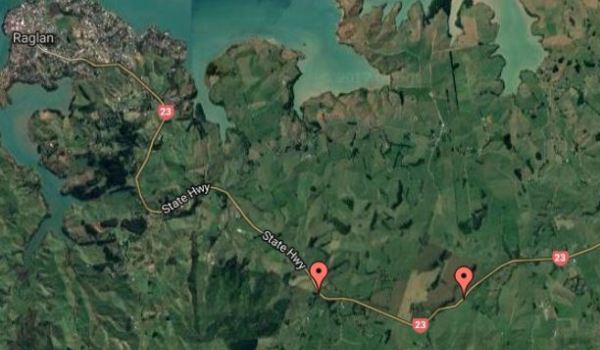A permanent speed camera is coming to SH 23 soon. NZ Police announced on 10th May that they would be installing a new digital static speed camera on Main Road, Raglan. Main Road is the short stretch of road from the 50 kph sign near Manukau Road to the BP opposite Norrie Avenue. It seems that the Police have confused their road names as after drilling down into information they provided, we’ve found that the speed camera will be installed between Raglan and Te Uku on SH 23. The exact location is between GPS location -37.833740, 174.917244 and location -37.834374, 174.940296. There is no ‘go live date’ given for the camera. Police say, that Downer ITS, the successful tenderer will break ground on construction of this camera and 32 other new static (or fixed) camera sites across the country in coming months.
These map coordinates translate in real terms into the stretch of SH 23 between Te Mata Road and Van Houtte Road.
NZ Police say that this location has been selected as a place with the highest risk of a speed-related crash, based on detailed independent analysis as part of the Government’s Safer Journeys road safety strategy. This includes predictive modelling of sites where there is an identified crash risk, and/or where research shows a history of crashes causing death and/or serious injury.
National Manager Road Policing, Superintendent Steve Greally, says each site was carefully selected following detailed analysis by independent experts and consultation with territorial authorities and local communities.
Installation of the cameras will happen gradually as the sites are constructed over the coming months.
“Each camera will then be subject to a comprehensive testing programme to ensure they are working accurately before going live, and we will give the public notice of when this will happen,” Mr Greally says.
It is anticipated that the cameras will begin operating from early next year, subject to progress on site works, engineering assessments and appropriate testing.
“As with the placement of other fixed cameras, details of each camera’s location are being made publicly available, as we want people to know where they are and encourage them to drive at safe speeds, so that we don’t have to issue notices.”
None of the infringements generated by drivers who trigger the cameras are retained by Police, but go to the Government’s consolidated fund.
“This is about encouraging drivers to make good choices and travel at a safe and appropriate speed for the conditions, which will see fewer people killed and injured on the roads,” Mr Greally says.
“This is supported by evidence which shows that static (or fixed) cameras on average reduce fatal and serious injury crashes by about 20% within the sphere of influence of the camera (up to about 1 km).”
Plans to expand New Zealand’s static (or fixed) camera network were first signalled in July 2013, and have been well publicised since then as new cameras have been progressively rolled out.
There are already 15 of the new cameras in place, with two of these still undergoing final testing before becoming operational.
